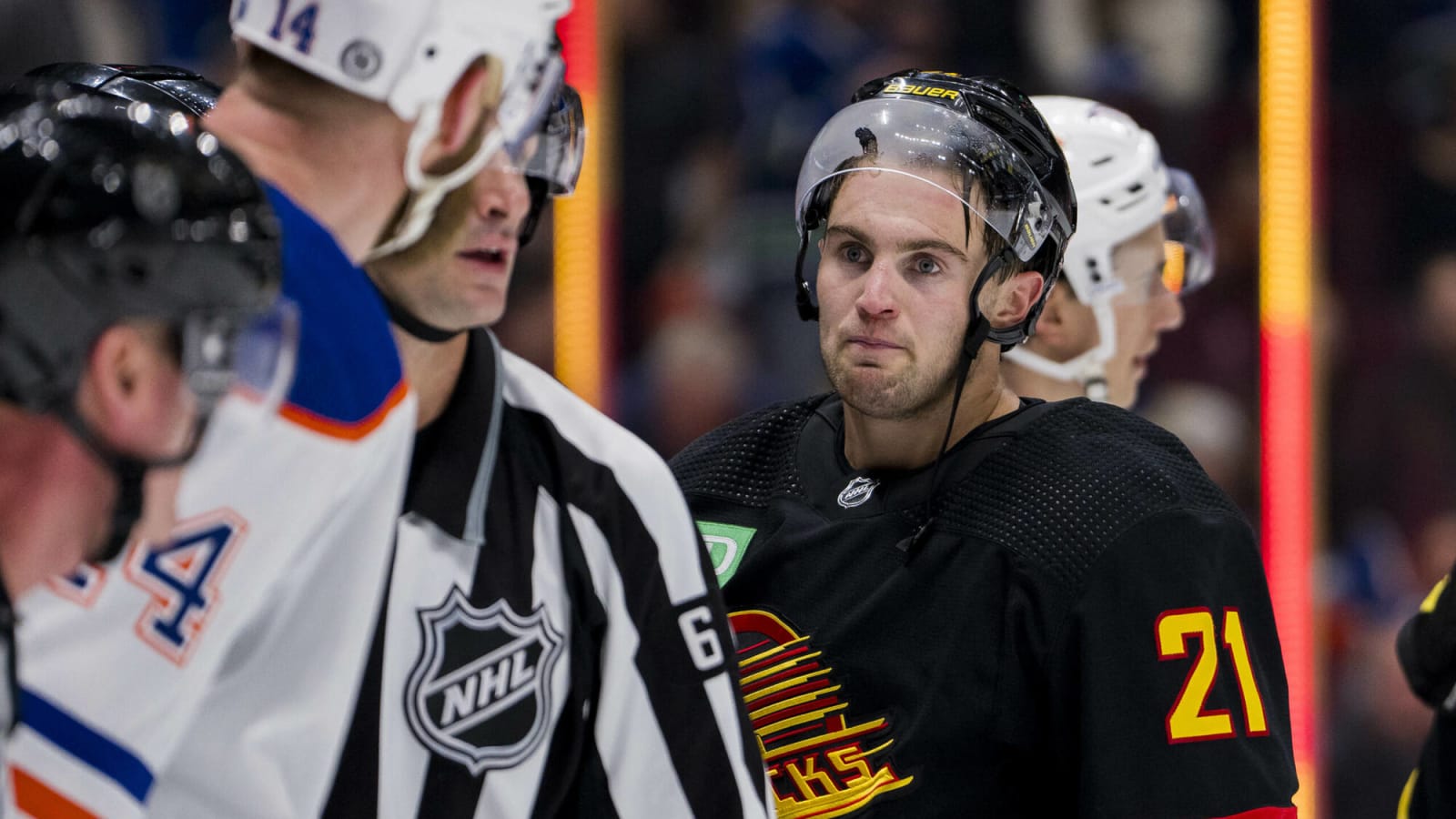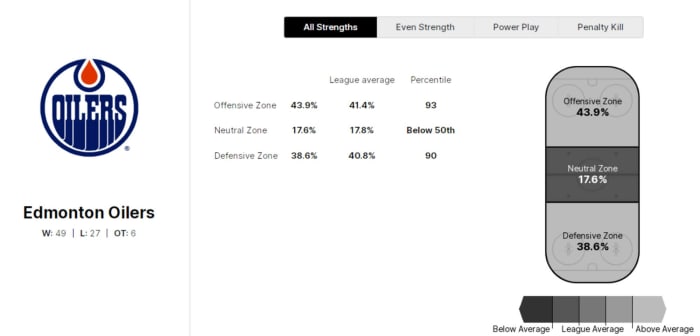
The stage is set, and it will be a Battle of Canada in round two as the Vancouver Canucks take on the Edmonton Oilers.
It was pure domination for the Canucks in the regular season, outscoring the Oilers 21-7, only ever trailing twice for a total of 13:31 minutes of game time. To expect the same type of lopsidedness is unrealistic. The playoffs are a different beast, but let’s dive into how the regular season went.
The Regular Season Matchup
Here is the analytical breakdown from all four games at all strengths.

By just looking at the underlying numbers, you’d imagine that the Oilers would be the ones to have won the season series as out-chanced the Canucks in three of four games. However, a bit of this can be categorized as a result of the Canucks having early leads, forcing the Oilers to play with more desperation and offensive zone time.
The most significant discrepancy between these two teams has to be the goaltending. The Oilers’ goaltending situation was a mess to start the year. Jack Campbell played in only the first game against Vancouver, in which he got pulled after allowing four goals on 16 shots. To the Oilers’ disappointment, Stuart Skinner wasn’t any better, as he also allowed four goals on 16 shots.
Throughout all four games, Skinner and Campbell combined for a -8.32 goals saved above expected. No wonder they lost the season series.
Now, it’s important to remember that the Oilers are a much different team from what they were at the beginning of the season. Since the calendar flipped to 2024, the Oilers tied the Carolina Hurricanes for the most points in the NHL. By all means, they won’t be an easy out for the Canucks.
But let’s look into some ways to exploit their new opponents.
The Zone Breakdown
With data provided by NHL Edge, we can see the percentage of time the Oilers spend in all three zones.

The Oilers spend 43.9% of their time in the offensive zone, which ranks in the 93rd percentile, and 38.6% in the defensive zone, which ranks in the 90th percentile.
Ranking in the 93rd percentile in the league is a feat not to be taken lightly. The Oilers’ cycling ability and crisp passing keep them generating scoring chances in the offensive zone, but how do they get into the zone?
*All videos are credited to Bruce Curlock’s YouTube channel.
Offensive Zone Tactical Breakdown
The Oilers make the offensive zone look easy. At the beginning of the Kings’ series, they fell into the trap of the 1-3-1. But not long after, they learned that their speed would be the killer of the defensive strategy.
On this play, the puck carrier holds the puck while three Oilers gain speed through the neutral zone, and the F1 sneaks behind the wall of three Kings. With the puck on the right side and two forwards streaming along the off-wing, this pulls two players to the other side, allowing for an easy pass and entry to the player behind the wall.
Edmonton’s offensive zone entry seems too easy for them.
They use Connor McDavid’s speed to glide through defenders and enter the zone. That’s their advantage. Teams have to respect McDavid’s speed and start back-pedalling much earlier to try and match his speed by the time he meets them. This gives McDavid so much space in front of him that he can either make a move or stop on a dime and easily gain the zone.
The Oilers, like the Canucks, are so intense along the boards. They win more board battles than they lose and are tenacious on the puck until they retrieve it. And when they do gain possession, they aren’t afraid to utilize their defencemen.
Vancouver is a well-positioned team in the defensive zone. When the play is sent to the blue line, there is always the F1 or F2 there to close the space and push them to the outside, forcing defenders to dump the puck along the wall or in the corner. And when things go array in the defensive zone, rarely do the Canucks not have a forward covering for the F3 position (defensive forward role).
It’s going to take a lot of work to defend the Oilers’ high-flying offensive attack, but keeping play along the outside with proper positioning is going to be necessary to limit the Oilers’ high-danger chances.
Neutral Zone Tactical Breakdown
The Oilers play a standard 1-2-2 formation coming through the neutral zone, similar to the structure the Canucks like to defend the neutral zone. This formation has the F1 pressuring the puck carrier while the F2 and F3 positions clog the middle of the neutral zone, while the D1 and D2 hang around the blue line in case a pass goes beyond the F2 and F3.
Evander Kane (F1) pressures the puck carrier early before the Kings forwards could get in position, forcing Drew Doughty to make a quick pass along to Trevor Moore on the left wing, which is out of his reach.
This wild pass leads to a turnover to the Oilers defender, and their forwards immediately jump into proper positioning for attack mode. The trio of forwards creates a triangle to maintain possession and set up in the offensive zone.
A little bit of the same here:
The F1 pressures the puck carrier behind the net and continues his chase. Left with minimal room, the Kings’ defenceman has no choice but to dump the puck into the zone.
But by no means is the Oilers transition game perfect.
Here, you can see Evan Bouchard make a great play to intercept the pass behind the net. He makes a great breakup pass to Adam Henrique, who carries the puck out of the zone but is quickly pressured by two back checkers. Henrique makes the right decision to pull up and gain himself space but makes a bad pass to Mattias Ekholm with the F1 hot on his tail.
This poor pass forces Ekholm to think fast and try to dump in the zone, which gets blocked. This is the worst-case scenario for the Oilers, as the back three Oilers skaters all have momentum going forward, leading to a Viktor Arvidsson break the other way.
That’s something the Canucks get definitely take advantage of.
Vancouver’s neutral zone consistently switches the F1 position. The pressuring F1 gains speed toward the puck carrier and swoops by to match the speed of the surging opposition along the wing to cover him. Then, the F2 position gains speed to chase the puck carrier.
This constant movement in the neutral zone leaves tiny windows for the opposition to get passes through, ultimately leading to this J.T. Miller intercept in the neutral zone and a 2-on-1 with Brock Boeser.
This, in turn, leads to less defensive zone time. But how do the Oilers stay out of their own end so well?
Defensive Zone Tactical Breakdown
One thing I’ve noticed about this Edmonton Oilers team is they can often get caught puck-watching. This results in players being out of position, as shown in this video:
Zach Hyman is the F3 (defensive forward), so it’s his responsibility to pressure the puck, and the centreman (Leon Draisaitl) should be the one to cover the point.
Instead, Draisaitl gets caught puck-watching and allows a pass up the middle. Luckily for the Oilers, nobody was in the slot area for the high-danger scoring chance, but it was still a pass up the middle. Hyman pressures the point man, but Draisaitl is still caught gliding, just watching the play and rubbing shoulders with his defender in the slot.
Draisaitl finally decides to pressure the puck carrier but chases him to the point where Hyman is and leaves his F3 forward wide open along the opposite half-wall. The pass to the open man forces the defenceman to leave the front of the net to pressure the open man, leaving the net front player all alone. This mispositioning in the defensive zone leads to a sloppy penalty.
One glaring weakness in this Oilers’ defence is their pinching. Their defencemen get caught pinching often, which leads to a lot of rush chances and 2-on-1s going the other way.
The pinching Darnell Nurse exposes an open lane right up the middle for Blake Lizotte to take the pass with speed into the offensive zone. This leads to a goal as Cody Ceci is out of position.
The Canucks are going to need to take advantage of the weaknesses the Oilers have displayed in round one. The Canucks are very good at cycling the puck in the offensive zone; the movement provided from down low can often result in some puck-watching from the opposition. Long-stretch passes from Quinn Hughes could lead to a pinching Oilers defenceman and a high-end rush chance going the other way. When these opportunities become available, the Canucks best not miss.
Let’s not forget the first goal of the Canucks season was against a pinching Oilers defenceman.
Connor Garland scores the first goal of the season! pic.twitter.com/DwMfppi6J9
— CanucksArmy (@CanucksArmy) October 12, 2023
So, what do you think Canucks fans? How do you think the Canucks match up against the Oilers tactically in all three zones?
More must-reads:
- Panthers star named winner of 2024 Selke Trophy
- Report: 2023 No. 7 pick expected to terminate KHL contract, join Flyers
- The 'Most triple-doubles in the postseason' quiz
Breaking News
Customize Your Newsletter
 +
+
Get the latest news and rumors, customized to your favorite sports and teams. Emailed daily. Always free!

